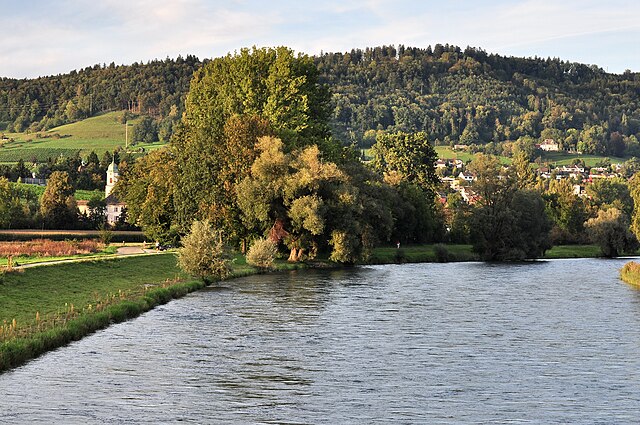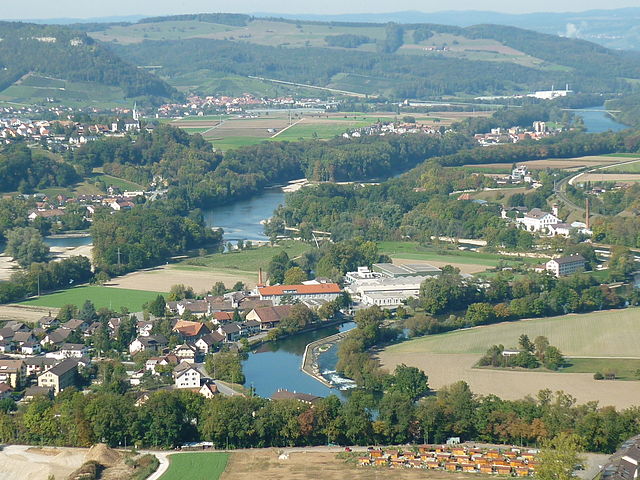Limmat
River in Switzerland From Wikipedia, the free encyclopedia
The Limmat is a river in Switzerland. The river commences at the outfall of Lake Zurich, in the southern part of the city of Zürich. From Zürich it flows in a northwesterly direction, continuing a further 35 km until it reaches the river Aare. The confluence is located north of the small town of Brugg and shortly after the mouth of the Reuss.
| Limmat | |
|---|---|
 The Limmat in Zürich, looking downstream to Rathausbrücke from Quaibrücke at Lake Zurich, Stadthausquai to the left and Limmatquai to right. | |
 | |
| Location | |
| Country | Switzerland |
| Cantons | Zürich, Aargau |
| Settlements | Zürich (ZH), Schlieren (ZH), Dietikon (ZH), Oetwil a.d.L. (ZH), Wettingen (AG), Baden (AG), Ennetbaden (AG), Nussbaumen (AG), Turgi (AG), Untersiggenthal (AG) |
| Physical characteristics | |
| Source | |
| • location | Lake Zurich, Zürich |
| • coordinates | 47.36677°N 8.54316°E |
| • elevation | 406 m (1,332 ft) |
| Mouth | |
• location | Aare, Gebenstorf |
• coordinates | 47.5019°N 8.2375°E |
• elevation | 328 m (1,076 ft) |
| Length | 36.3 kilometres (22.6 mi), 140 kilometres (87 mi) (Lake Zurich and Linth included) |
| Basin size | 2,416 km2 (933 sq mi) (Lake Zurich and Linth included) |
| Discharge | |
| • location | Baden |
| • average | 101.0 m3/s (3,570 cu ft/s) (MQ 1951-2013) |
| • minimum | 69.2 m3/s (2,440 cu ft/s) (MNQ 1951-2013), 24.6 m3/s (870 cu ft/s) (NNQ, 2003) |
| • maximum | 141 m3/s (5,000 cu ft/s) (MHQ 1951-2013), 657 m3/s (23,200 cu ft/s) (HHQ, 1999) |
| Basin features | |
| Progression | Aare→ Rhine→ North Sea |
| Tributaries | |
| • left | Sihl, Schäflibach, Reppisch, Dorfbach Spreitenbach |
| • right | Länggenbach, Furtbach, Lugibach, Gottesgraben |
| Waterbodies | Lake Zurich, Stausee Wettingen |






The main towns along the Limmat Valley downstream of Zürich are Dietikon, Wettingen, and Baden. Its main tributaries are the Linth, Wägitaler Aa and Jona, all via Lake Zurich, the Sihl in Zürich, and the Reppisch in Dietikon.
The hydronym is first attested in the 8th century, as Lindimacus. It is of Gaulish origin, from *lindo- "lake" (Welsh llyn) and *magos "plain" (Welsh maes), and was thus presumably in origin the name of the plain formed by the Linth.[1]
Power generation
Like many Swiss rivers, the Limmat is intensively used for production of hydroelectric power: along its course of 35 km (22 mi), its fall is used by no less than ten hydroelectric power stations. These include:
| Station | Capacity (MW) | Location | Geographic coordinates |
|---|---|---|---|
| Aue Power Station[2] | 3.9 | Baden | 47°28′13″N 8°18′40″E |
| Dietikon Power Station[3] | 2.6 | Dietikon | 47°24′36″N 8°24′30″E |
| Höngg Power Station[4] | 1 | Zürich | 47°24′07″N 8°29′13″E |
| Kappelerhof Power Station[2] | 6.8 | Baden | 47°29′04″N 8°17′35″E |
| Letten Power Station[5] | 4 | Zürich | 47°23′15″N 8°31′56″E |
| Schiffmühle Power Station[2] | 2.6 | Untersiggenthal | 47°29′19″N 8°15′54″E |
| Turgi Power Station[2] | 1 | Turgi | |
| Wettingen Power Station[6] | 26 | Wettingen | 47°27′24″N 8°19′14″E |
Navigation
Historically, the Limmat was an important navigation route. In the twelfth and thirteenth centuries, voyages from Zürich to Koblenz are recorded. In 1447, the Emperor Frederick III granted the privilege of free navigation on the Limmat and on the Rhine to Zürich. Because of the current, navigation was typically downstream only, with the barges being sold on arrival.[7]
Today, the Limmat is navigable for much of its length by small craft only, with many of the hydroelectric power plants incorporating boat lifts. The traditional boat type used on the river is the weidling, a flat-bottomed vessel that is usually 10 metres (33 ft) long.[8][9]
The uppermost stretch of the river through the centre of Zürich is navigable by rather larger vessels, albeit limited by low bridges. On this stretch of the river the Zürichsee-Schifffahrtsgesellschaft (Lake Zurich Navigation Company) operates its Limmat boat service, from the Landesmuseum to Lake Zurich, using low-profile motor boats.[10]
Towns near the river
Cultural heritage
Located on the swamp land between Limmat and Lake Zurich around Sechseläutenplatz on small islands and peninsulas in Zürich, Prehistoric pile dwellings around Lake Zurich were set on piles to protect against occasional flooding by the Linth and Jona. Zürich–Enge Alpenquai is located on Lake Zurich lakeshore in Enge, a locality of the municipality of Zürich. It was neighbored by the settlements at Kleiner Hafner and Grosser Hafner on a then peninsula respectively island in the effluence of the Limmat, within an area of about 0.2 square kilometres (49.42 acres) in the city of Zürich. As well as being part of the 56 Swiss sites of the UNESCO World Heritage Site Prehistoric pile dwellings around the Alps, the settlement is also listed in the Swiss inventory of cultural property of national and regional significance as a Class object.[11][12][13]
See also
References
External links
Wikiwand in your browser!
Seamless Wikipedia browsing. On steroids.
Every time you click a link to Wikipedia, Wiktionary or Wikiquote in your browser's search results, it will show the modern Wikiwand interface.
Wikiwand extension is a five stars, simple, with minimum permission required to keep your browsing private, safe and transparent.
